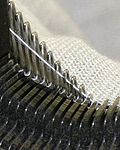Knitting
Knitting creates flexible fabric by looping thread or yarn together using two or more knitting needles or a knitting machine.
Types of knitting
Flat knitting
Flat knitting, which is usually done on two straight needles, makes a length of cloth and is used to create things like blankets, scarves, and the backs, fronts, and sides of sweaters.
Circular knitting
Circular knitting, which is done on circular needles, or needles that have points on both ends, produces a seamless tube and is used to create things like hats, socks, mittens, rings, and sleeves.
Cable knitting
Patterns called cables are typically used on sweaters, particularly on fancy Aran sweaters from Ireland. Different kinds of stitches create different patterns in knitting. For example, the stretchy ends of knitted sleeves are called ribbing.
Materials
Yarn
Knitting Media
Video description of knitting a sock and the two basic stitches: knit and purl
Structure of stockinette stitch, a common weave in knitted fabric. The meandering red path defines one course, the path of the yarn through the fabric. The uppermost white loops are unsecured and "active", but they secure the red loops suspended from them. In turn, the red loops secure the white loops just below them, which in turn secure the loops below them, and so on.
A modern knitting machine in the process of weft knitting
Yarn for knitting can be made from any number of natural or synthetic (man made) fibers such as wool, cotton, silk, or acrylic. Some yarns are made from a blend of several kinds of fibers.
Yarns come in many thicknesses or weights from fine to thick: lace, fingering, sock, sport, double-knit (or DK), worsted, Aran, bulky, and super-bulky. Thinner yarns are generally used with smaller knitting needles, and thicker yarns are used with larger knitting needles.
Needles
Knitting needles come in various shapes: straight, double-pointed, cable, and circular. They can be made from bamboo, aluminum, steel, or plastic.









